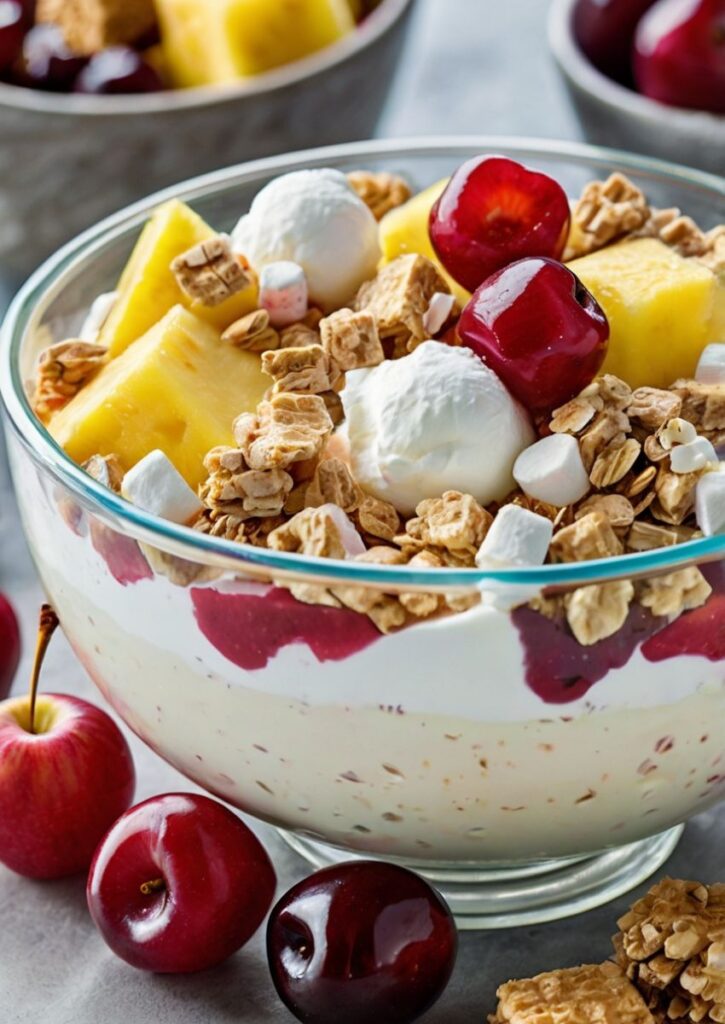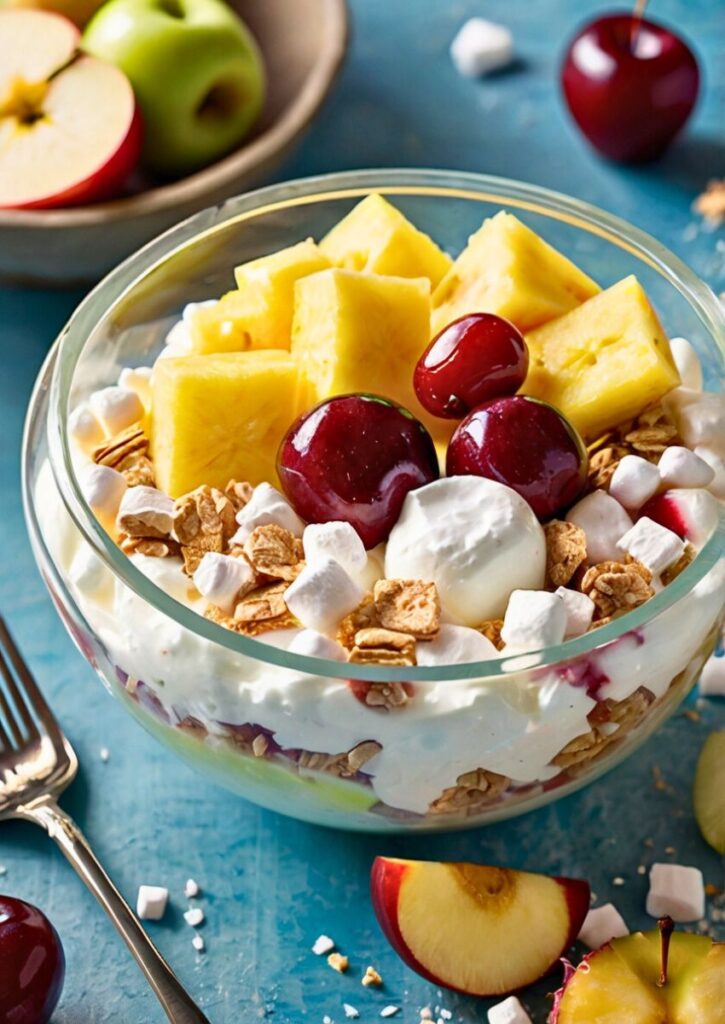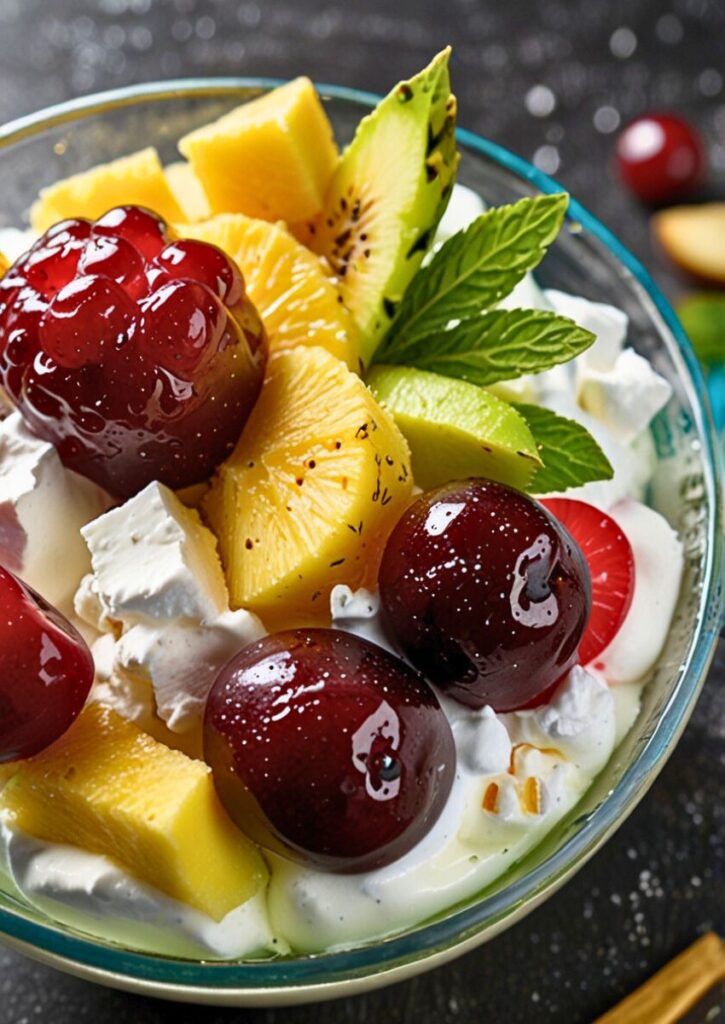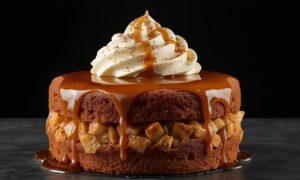Have you ever craved a dessert that’s cool, creamy, and bursting with fruity goodness? That’s the magic of Creamy Fruit Salad. It’s the dish that shows up at every summer picnic, family party, or holiday table and for good reason. It’s fast, fresh, and full of flavor.
I grew up watching my mother whip up Creamy Fruit Salad in minutes. A handful of juicy fruits. A swirl of smooth cream. A sprinkle of something sweet. The result? Pure joy in a bowl. It wasn’t fancy, but it never lasted long.
In this post, I’ll show you how to make your own Creamy Fruit Salad that tastes as good as it looks. You’ll learn the best fruit combos, the secret to that rich, dreamy texture, and how to keep everything crisp and fresh. No baking. No stress. Just a crowd-pleaser you can throw together anytime.
And here’s the best part this dessert fits every mood. Light enough for a hot day. Sweet enough to end a meal. Pretty enough to impress. One bite, and you’ll wonder why you didn’t make it sooner.
What Makes Creamy Fruit Salad Special
Creamy Fruit Salad is more than just a quick dessert, it’s a moment of comfort wrapped in color and flavor. At first glance, it may look like a humble bowl of fruit and cream, but there’s a quiet brilliance behind its simplicity.
You see, it’s not just about tossing fruits into a bowl. It’s about knowing which ones play well together, how to balance their textures and acidity, and how to fold everything into a creamy base that feels light but luxurious. When done right, creamy fruit salads become something more—something that can hold their own at fancy brunch tables just as easily as they do at backyard potlucks.
Professional kitchens understand this. They elevate creamy fruit salads by picking fruits at their peak, whipping cream to just the right consistency, and timing it all so the textures stay crisp and vibrant. It’s the little things, how you treat the cream cheese, the type of cream you use, and when you cut the fruit, that make all the difference.
And here’s a fun bit of kitchen wisdom: not all fruits behave the same way with cream. Some soften, some hold firm, and some add just the right tartness to cut through the richness. When you understand those small details, your creamy fruit salad won’t just be good, it’ll be unforgettable.
Ingredients & Substitutions

Primary Fruits (Choose 4-5 varieties)
- 2 cups fresh strawberries, hulled and quartered
- 2 cups fresh pineapple, cored and chunked
- 3 ripe but firm bananas, sliced
- 2 cups seedless grapes, halved
- 2 cups fresh blueberries
- 1 cup fresh raspberries
Cream Base Components
- 8 oz cream cheese, room temperature
- 1 cup heavy whipping cream
- ½ cup powdered sugar
- 2 tablespoons vanilla extract
- 1 tablespoon fresh lemon juice
- Pinch of salt
Optional Enhancements
- 2 tablespoons honey or maple syrup
- 1 teaspoon orange zest
- ¼ cup toasted coconut flakes
- 2 tablespoons chopped fresh mint
The foundation of exceptional creamy fruit salad starts with ingredient selection that most home cooks overlook. Cream cheese must reach room temperature naturally never microwave it, as this breaks the protein structure and creates grainy texture. Professional kitchens remove cream cheese from refrigeration 3-4 hours before service.
Heavy whipping cream with 35-40% fat content produces the most stable foam structure. Lower fat alternatives collapse within hours, creating watery separation that ruins presentation.
Smart Substitutions for Dietary Needs: Replace cream cheese with mascarpone for ultra-rich texture, or use Greek yogurt mixed with cashew cream for dairy-free versions. Coconut cream works excellently for vegan preparations, though it requires different stabilization techniques.
For sugar alternatives, erythritol or monk fruit sweetener maintain the powdered consistency necessary for smooth cream integration. Avoid liquid sweeteners as they alter the cream’s binding properties.
Fruit Selection Secrets: Choose fruits with varying textures and acidity levels. Strawberries provide tartness, pineapple adds tropical sweetness with natural enzymes that tenderize other fruits, while grapes contribute satisfying crunch contrast.
Bananas must be perfectly ripe yellow with just a few brown spots. Overripe bananas turn mushy within hours, underripe ones never develop their characteristic sweetness.
Step-by-Step Instructions

Stage 1: Cream Base Preparation
Start with room-temperature cream cheese in a large mixing bowl. This cannot be emphasized enough cold cream cheese creates lumps that never fully incorporate, even with extended mixing. Beat the cream cheese with paddle attachment on medium speed for 2-3 minutes until completely smooth and fluffy.
Add powdered sugar gradually while mixing. The key here is patience; rushing this step creates a gritty texture that screams amateur preparation. Professional kitchens sift powdered sugar twice to eliminate any lumps that could compromise the final texture.
Incorporate vanilla extract, lemon juice, and salt. The lemon juice serves dual purposes: it brightens the overall flavor profile while providing citric acid that helps stabilize the cream structure and prevents oxidation in sensitive fruits.
Stage 2: Whipped Cream Integration
In a separate chilled bowl, whip heavy cream to soft peaks this takes about 3-4 minutes with a stand mixer on medium-high speed. Watch carefully; overwhipped cream becomes grainy and eventually turns to butter, ruining the entire base.
The secret technique professional chefs use: add one-third of the whipped cream to the cream cheese mixture and fold gently with a rubber spatula. This lightens the base, making it easier to incorporate the remaining cream without deflating it.
Fold in remaining whipped cream using the “cut and fold” motion slice down through the center, scrape along the bottom, and lift up the sides. Rotate the bowl quarter-turns as you work. This maintains maximum air incorporation while ensuring even distribution.
Stage 3: Fruit Preparation and Assembly
Prepare fruits in order of oxidation resistance. Start with grapes and berries, which hold their color and texture longest. Cut strawberries last, as they release juice immediately upon cutting.
Professional Cutting Techniques: Strawberries: Remove hulls with a small paring knife, making a shallow cone cut to remove the white core. Quarter larger berries, halve smaller ones.
Pineapple: Core completely and cut into uniform ¾-inch chunks. Smaller pieces disappear into the cream, larger pieces dominate each bite.
Bananas: Slice just before serving, or treat with lemon juice to prevent browning. Professional tip: slice bananas slightly thicker than you think they soften during storage.
Stage 4: Final Assembly
Add prepared fruits to cream base in stages, folding gently after each addition. Start with firmer fruits like grapes and pineapple, then add softer berries. This prevents delicate fruits from breaking apart during mixing.
Taste and adjust sweetness if needed. Remember that fruit sweetness varies seasonally, so flexibility in final seasoning separates professional preparations from rigid recipe following.
Cooking Techniques & Science
Understanding the science behind creamy fruit salad transforms good cooks into exceptional ones. The cream base relies on fat globule stabilization when cream cheese and whipped cream combine properly, they create a network of fat and protein that suspends fruit pieces while maintaining smooth mouthfeel.
Temperature control affects every aspect of this dish. Cold ingredients don’t emulsify properly, while warm ingredients cause cream to separate. Professional kitchens maintain all components at 65-68°F during assembly.
Enzymatic Activity Management: Pineapple contains bromelain, an enzyme that breaks down proteins. In small quantities, this tenderizes other fruits pleasantly, but excessive amounts can break down the cream structure entirely. This is why fresh pineapple works better than canned canning deactivates most enzymes, but also removes the beneficial effects.
Citric acid from lemon juice neutralizes browning enzymes in apples, bananas, and pears while enhancing fruit flavors. The pH balance created by proper acid addition extends shelf life significantly.
Texture Science: Different fruits release moisture at varying rates. Strawberries release juice quickly, grapes slowly, blueberries hardly at all unless damaged. Professional assembly accounts for this by cutting fruits to sizes that balance moisture release with eating experience.
The cream base must be stable enough to hold fruit suspension but light enough to coat each piece evenly. This requires precise fat-to-water ratios that change based on humidity and temperature conditions.
Serving & Pairing Suggestions
Presentation Excellence
Serve creamy fruit salad in chilled glass bowls to showcase the colorful fruit distribution. Professional presentations use clear serving vessels that highlight the cream’s pristine white background against vibrant fruit colors.
For elegant plating, use a large spoon to create swooping motions in individual bowls, then garnish with a few perfect berries and a sprig of fresh mint. The contrast between creamy base and fresh garnish creates visual appeal that elevates the entire dish.
Temperature Service Notes: Serve slightly chilled, around 45-50°F. Too cold, and flavors become muted; too warm, and the cream loses its appealing texture. Professional kitchens remove creamy fruit salad from refrigeration 10-15 minutes before service to reach optimal temperature.
Complementary Pairings
Creamy fruit salad pairs exceptionally with rich, dense desserts where its light, fresh profile provides palate cleansing contrast. Consider serving alongside chocolate torte, dense cheesecake, or rich bread puddings.
For brunch service, pair with buttery pastries like croissants or danish, where the fruit’s acidity cuts through rich, buttery flavors beautifully.
Beverage Pairings: Champagne or Prosecco complement the creamy texture while their bubbles cleanse the palate between bites. For non-alcoholic options, sparkling water with fresh lime provides similar palate-cleansing effects.
Coffee service works excellently, as the slight bitterness contrasts beautifully with the sweet, creamy fruit combination.
Advanced Variations and Professional Tips

Seasonal Adaptations
Spring variations incorporate early berries with rhubarb for tartness balance. Summer versions maximize stone fruits peaches, apricots, and plums when they’re at peak ripeness and sweetness.
Fall adaptations include apples and pears with warming spices like cinnamon or cardamom. Winter versions focus on citrus fruits with pomegranate seeds for color and crunch contrast.
Professional Storage Techniques: Store fruit and cream base separately until service day to maintain optimal textures. Assembled salad holds well for 24 hours but quality degrades rapidly after that point.
Cover tightly with plastic wrap pressed directly onto the surface to prevent skin formation and oxidation. Professional kitchens often add a second layer of wrap around the entire container for maximum freshness protection.
Troubleshooting Common Issues
Separated Cream Base: Usually indicates temperature problems during assembly or overwhipped cream. Prevention requires strict temperature control and proper whipping technique.
Watery Consistency: Results from fruit moisture release or unstable cream base. Combat this by draining excess fruit juices before mixing and ensuring proper cream stabilization.
Bland Flavor: Often indicates under-seasoning or using out-of-season fruits. Professional kitchens adjust sweetness and acidity based on fruit quality and seasonal variations.
Conclusion
Mastering creamy fruit salad requires understanding that simplicity doesn’t mean carelessly throwing ingredients together. The difference between amateur and professional results lies in respecting each component’s unique properties and how they interact with others.
Temperature control, timing, and ingredient selection create the foundation for exceptional results. But technique alone isn’t enough you must taste, adjust, and adapt based on seasonal fruit variations and individual preferences.
This creamy fruit salad approach transforms a simple side dish into a dessert worthy of professional kitchens. The techniques you’ve learned here apply to countless other fruit-based preparations, making you a more versatile and knowledgeable cook overall.
Remember: great cooking comes from understanding why techniques work, not just following steps blindly. Apply these principles creatively, and you’ll develop your own signature variations that reflect your unique style while maintaining professional standards.
Frequently Asked Questions
Q: How long can creamy fruit salad be stored in the refrigerator?
A: Properly stored creamy fruit salad maintains optimal quality for 24-48 hours maximum. The cream base remains stable, but fruit textures degrade and release moisture that dilutes the overall consistency. For best results, consume within 24 hours of assembly. Professional kitchens never hold assembled fruit salads longer than one service period.
Q: Can I make creamy fruit salad ahead of time for large gatherings?
A: Yes, but use the component method. Prepare the cream base up to 2 days ahead and store covered in refrigeration. Prepare sturdy fruits (grapes, pineapple, berries) the morning of service. Cut delicate fruits like bananas and strawberries no more than 2 hours before serving. Combine all components just before presentation for optimal texture and appearance.
Q: What causes the cream base to become watery or separated?
A: Separation typically occurs from temperature fluctuations, overwhipped cream, or fruit moisture release. Ensure cream cheese reaches room temperature naturally, whip cream only to soft peaks, and drain excess juice from cut fruits before mixing. Once separated, the texture cannot be restored prevention is the only solution.
Q: Which fruits should I avoid in creamy fruit salad?
A: Avoid fruits with high water content like watermelon or cantaloupe, as they release excessive moisture that breaks down the cream structure. Skip overly soft fruits like very ripe peaches or mangoes that become mushy quickly. Citrus segments work but remove all white pith to prevent bitter flavors that clash with the sweet cream base.
Q: How do I prevent bananas from browning in the salad?
A: Slice bananas just before serving, or toss cut pieces immediately with fresh lemon juice. The citric acid prevents enzymatic browning for several hours. Professional tip: slightly under-ripe bananas hold their color longer and maintain better texture in creamy preparations. Never add pre-cut bananas that have been stored they’ll turn the entire salad an unappetizing brown color.

Swiftly Captions by Tina Smith — Quick, flavorful food recipes made simple, bringing fresh inspiration to your kitchen every day






